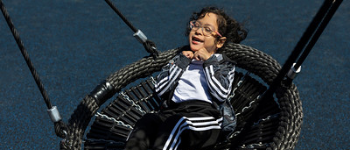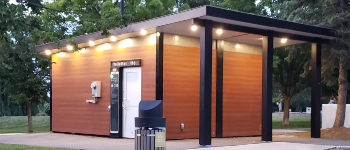How To Make Sure Your Playground is ADA Compliant
Jun 24







Aug 01
We celebrated 35 years of the Americans with Disabilities Act (ADA) this July, an act that provides the foundation for protecting people with disabilities from discrimination, on the playground and beyond. The spirit of the ADA is marked by ensuring equal access and opportunity for people with disabilities, so everyone can stay active, enjoy sports, and fully participate in recreation across the country. This is specifically important in playgrounds. It is not only our moral imperative to create spaces where all children and caretakers can comfortably play together, but a legal one. It is our goal to not only meet the ADA requirements, but to go above and beyond to create inclusive spaces where every child can gain a valuable experience. In this blog, we’ll demystify ADA compliance for playgrounds and share our expertise and resources.
The ADA, signed into law on July 26, 1990, prohibits the “discrimination against people with disabilities in several areas, including employment, transportation, public accommodations, communications and access to state and local government programs and services.” While parks and playgrounds fall under the category of “public accommodations,” playground designers and developers didn’t have much guidance for ensuring equal access to all people in such places until 2010. In 2010, the ADA released the Standards for Accessible Design, giving clear guidelines for playgrounds.
According to the ADA, to be accessible or inclusive, a playground must have the following:
Our team of experts can help determine how to best make your play area meet these standards through our surfacing, equipment, and other options. Let’s see how.
Pathways and surfacing are great places to start when it comes to meeting key ADA requirements, but it is also important to consider accessibility inside the play area. For example, once a child enters the playground, can they access all the equipment easily? Here’s our checklist of elements to meet the ADA requirements (and go beyond):
The ADA guidelines are vital and provide a sturdy foundation to build upon. By ensuring the needs of the ADA guidelines are met, we can explore how to make our playgrounds truly inclusive, exciting, and engaging.
Designing for true inclusion means going beyond the ADA’s framework. We partner with PlayCore and their Center for Outreach, Research and Education (CORE) to use scholarly, evidence-based research to inform our inclusive playground design. One of the core principles of inclusive playground design is the concept of universal design, meaning the design of products and environments to be usable by all people, to the greatest extent possible, without adaptation or specialized design.
There are so many ways to use the universal design principle to provide meaningful play experiences. Here are some examples:
When designing for true inclusion, a key choice is who you choose to partner with. Expertise and research in the field of inclusion is crucial for navigating the complex ADA guidelines, ensuring compliance, and incorporating thoughtful inclusive design. This is why we partner with PlayCore and CORE, as we touched upon above. Through CORE, we offer a variety of scholarly services in addition to the broadest selection of inclusive products to build complete play and recreation environments. With our partners at PlayCore, our in-house team with 50 years of experience, including Certified Playground Safety Inspectors (CPSIs), we are proud to ensure evidence-based, compliant inclusive design solutions.
In collaboration with the NYC Parks Department, we brought innovative design and universal accessibility together to create a playground that welcomes children of all abilities, in the heart of Brooklyn. Kelly Park features a fully accessible ramped structure, a custom maze installation, two areas designed for ages 2-5 and two zones catering to ages 5-12. The centerpiece is the accessible structure, integrated with a 6-foot-high concrete mountain that includes ramped access and a concrete path to the summit, ensuring the thrill of elevation for every child, regardless of mobility.
ADA compliance is more than a legal requirement; it's the starting point for creating equitable and accessible play opportunities for everyone. By ensuring that every child and caregiver can enjoy your playground, you're building a space that allows for genuine connection and growth where no one is left out, and everyone feels welcome and engaged. At MRC Recreation, we are dedicated to helping communities achieve compliance and, more importantly, go beyond it to build truly inclusive, joyful play spaces. We believe in partnering with you to bring a vision of universal play to life. If you're ready to create a playground that serves all members of your community, our team is here to help.
Explore our accessible playground solutions, learn more about our partnerships with PlayCore and CORE, or contact us today to schedule a consultation.